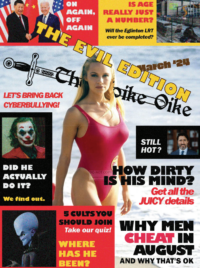In a shocking violation of academic regulations everywhere, The Toike Oike, the University of Toronto’s most-read newspaper per capita by individuals aged 17-25 standing directly in front of the newspaper stand on the basement level of the St. George Campus’ Sandford Fleming Building whilst wearing a leather jacket in the winter months while simultaneously respirating (N=3), has flagrantly stolen the entirety of a Wikipedia article in a feeble attempt to boost the volume of their written content for their already-behind-schedule February edition of the publication.
“For those of you unaware,” explained University of Toronto satire expert Professor Jordan B. Peterson, “Satire is a genre of literature, and sometimes graphic and performing arts, in which vices, follies, abuses, and shortcomings are held up to ridicule, ideally with the intent of shaming individuals, corporations, government, or society itself into improvement.[1] Although satire is usually meant to be humorous, its greater purpose is often constructive social criticism, using wit to draw attention to both particular and wider issues in society.”
Continuing his fascinating train of thought on satire, and by tenuous connection why The Toike Oike would want to plagiarise anything connected to it, Peterson further explained that “A feature of satire is strong irony or sarcasm—”in satire, irony is militant”[2][3]—but parody, burlesque, exaggeration,[4] juxtaposition, comparison, analogy, and double entendre are all frequently used in satirical speech and writing. This “militant” irony or sarcasm often professes to approve of (or at least accept as natural) the very things the satirist wishes to attack.”
Although at this point becoming tedious, Peterson concluded by saying that “Satire is nowadays found in many artistic forms of expression, including internet memes, literature, plays, commentary, television shows, and media such as lyrics.[citation needed]” He additionally remarked that the perfidious plagiarisers likely hadn’t actually stolen the entire article, but just the beginning part so as to fit a plausible newspaper article length.
Resident newspaper connoisseurs further remarked that it was highly unfortunate that the Toike article in question didn’t include the citations from the original Wikipedia article. Not only to defray some of the guilt involved in the theft of content, but additionally because the majority of said citations were from Northrop Frye, the mere mention of whom would attract nearby students of Victoria College to the newspaper’s readership, much like the idea of classist oppression attracts students of Trinity College.
[1] Elliott 2004.
[2] Frye, Northrop, quote[1] (literary critic).
[3] Frye, Northrup (1957). Anatomy of Criticism. Princeton: Princeton UP. p. 222. ISBN 0-691-06004-5.
[4] Claridge, Claudia (2010) Hyperbole in English: A Corpus-based Study of Exaggeration p.257



